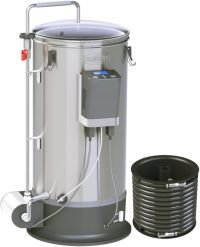Buyer’s Guide to Home Brewing
 Buyer’s Guide to Home Brewing
Buyer’s Guide to Home Brewing
Here’s the ultimate buyers guide to home brewing to help you choose the essential equipment you’ll need for your homebrewing setup.
Are you interested in trying your hand at home brewing? Whether you’re a beginner or an experienced brewer, having the right equipment is crucial for creating a delicious batch of beer.
Essential Equipment
Brewing Kettle
A brewing kettle is an essential piece of equipment for homebrewing. It’s where you’ll boil your wort and add hops and other ingredients. Look for a kettle that’s made of durable material, such as stainless steel, and has a capacity of at least 5 gallons. A larger kettle will give you more flexibility to brew larger batches or high gravity beers. Look for a kettle that’s easy to clean and has a spigot for transferring your wort to your fermenter.
Fermenting Vessel
After boiling your wort, you’ll need a vessel to ferment it in. You can use a plastic bucket or a glass carboy, but make sure it’s large enough to hold your batch of beer. Consider a vessel with a spigot or airtight seal to make the bottling process easier. A clear fermenting vessel will allow you to monitor the progress of your fermentation and detect any potential problems. Avoid using metal containers for fermentation as they can react with the acids in the beer and produce off-flavors.
STOPPERS
Airlock and Stopper
An airlock and stopper are essential for preventing contamination during fermentation. The airlock allows gases to escape while preventing air from entering the fermenting vessel. Make sure to choose an airlock and stopper that fit your fermenting vessel. A three-piece airlock is easier to clean than a one-piece airlock and allows you to add sanitizing solution.
THERMOMETERS AND TUBING
Hydrometer
A hydrometer is a tool used to measure the specific gravity of your wort and fermented beer. This helps you determine the alcohol content and whether fermentation is complete. Look for a hydrometer that’s easy to read and comes with a testing jar. A temperature correction chart should also be included as the specific gravity reading is affected by the temperature of the liquid.
Thermometer
A thermometer is essential for monitoring the temperature of your wort and fermentation vessel. Look for a thermometer with a range that’s suitable for brewing and that’s easy to read. A digital thermometer with a probe that can be immersed in the liquid is more accurate than a floating thermometer.
Auto-Siphon and Tubing
An auto-siphon and tubing are essential for transferring your beer from the fermenting vessel to the bottling bucket or bottles. Look for tubing that’s food-grade and fits snugly on your siphon and bottling bucket or bottles. An auto-siphon is easier to use than a manual siphon and minimizes the risk of contamination.
BOTTLING AND CLEANING
Bottling Equipment
You’ll need bottling equipment, such as a bottling bucket, bottle filler, and capper, to bottle your beer. Look for equipment that’s easy to use and durable. A bottling bucket with a spigot makes it easier to transfer your beer to your bottles without disturbing the sediment. A bottle filler that can be adjusted to the appropriate fill level is more efficient and produces less spillage.
Cleaning and Sanitizing Equipment
Keeping your brewing equipment clean and sanitized is essential for preventing contamination and creating delicious beer. Look for a cleaning and sanitizing kit that includes a cleaner, sanitizer, and brushes. Avoid using household cleaners and bleach as they can leave residues and affect the taste of your beer. A no-rinse sanitizer is easier to use and more effective than a rinse sanitizer. Use brushes to clean hard-to-reach areas of your equipment.
Kits
Ingredient Kits
Ingredient kits are a great way to get started with homebrewing. They contain all the ingredients you need to make a specific style of beer and come with detailed instructions. Look for kits that are suitable for your brewing experience level and include high-quality ingredients. You can also experiment with different ingredients and create your own recipes.
Stir Plate and Yeast Starter Kit
A stir plate and yeast starter kit can help you grow healthy yeast for your beer. Yeast starters ensure that there’s enough yeast to ferment your beer and reduce the risk of off flavors. Look for a kit that’s easy to use and includes a stir plate, Erlenmeyer flask, and yeast nutrient. You can also make a yeast starter without a stir plate using a sterilized jar and some yeast nutrient.
WATER TESTING
Water Testing Kit
Water chemistry is an important factor in brewing beer. A water testing kit can help you determine the pH and mineral content of your water and adjust it to suit your brewing needs. Look for a kit that’s easy to use and includes all the necessary reagents and instructions. You can also send a water sample to a lab for analysis.
KEGGING AND STORAGE
Kegging Equipment
Kegging your beer is a convenient way to store and dispense it. Look for kegging equipment that’s easy to use and maintain. You’ll need a keg, CO2 tank, regulator, hoses, and a tap. Consider a keg with a capacity of at least 5 gallons and a dual-gauge regulator that allows you to monitor the pressure and volume of CO2. Kegging equipment can be expensive, but it’s a worthwhile investment if you plan on brewing frequently.
Storage and Serving Equipment
Once your beer is bottled or kegged, you’ll need storage and serving equipment. Look for equipment that’s suitable for your batch size and serving preferences. A temperature-controlled refrigerator or freezer is ideal for storing your beer and serving it at the appropriate temperature. You’ll also need glasses, coasters, and a bottle opener or tap handle.
Useful Extras
Brewing Software
Brewing software can help you calculate recipes, track your brewing process, and monitor fermentation. Look for software that’s easy to use and has features that are relevant to your brewing needs. Some software can also help you keep track of inventory, schedule brew days, and share recipes with other brewers.
Books and Resources
There’s a wealth of information available on homebrewing. Along with the buyer’s guide to home brewing Look for books, websites, and forums that provide useful tips and advice. Some books cover the basics of homebrewing, while others focus on specific styles or techniques. Websites and forums can provide valuable feedback on your recipes and brewing process. Attend local homebrewing events and join a homebrewing club to connect with other brewers and learn from their experience.


